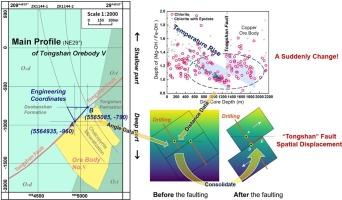Study of Short-Wave Infrared spectroscopy (SWIR) on hydrothermal chlorite in the Tongshan porphyry Cu-Mo deposit, Heilongjiang
IF 3.6
2区 地球科学
Q1 GEOLOGY
引用次数: 0
Abstract
Short-Wave Infrared spectroscopy (SWIR) is widely used in the study of the mica-type minerals such as muscovite, phengite, phlogopite, and paragonite for mineral exploration. However, for dark-colored mineral chlorite, which is also a common hydrothermal mineral in most magmatic-hydrothermal systems, there are fewer key indicators available. This study performed a systematic SWIR analysis on four ∼2000 boreholes, along the newly discovered Ore Body V in the Tongshan porphyry Cu-Mo deposit. Systematic petrographic observations were conducted and the four boreholes here are primarily composed of andesitic tuff and porphyritic andesite of the Duobaoshan Formation. No distinct alteration mineral zoning was observed, with chloritization is widespread in the shallow part, accompanied by minor epidotization and carbonation (i.e. chlorite with small amount of sericite-epidote-calcite), while the ore body in the deeper part of the cores exhibits chloritization, silicification, chalcopyrite alteration, and pyritization (i.e. chlorite-sercite-chalcopyrite-pyrite). No porphyritic intrusions or large-scale potassic alteration related to copper mineralization were found in Ore Body V. SWIR analysis revealed that at the “Tongshan” fault, the absorption peak of Fe-OH in chlorite decreases from ∼2255 nm to ∼2253 nm. After evaluating the interference of epidote, the “SWIR-IC” of chlorite exhibits a linear decreasing trend with borehole depth both before and after the fault, dropping from approximately 1.4 to below 1.0, and found it may indicate the formation temperature. This trend of chlorite undergoes significant changes near the “Tongshan” fault, shifting from approximately 0.8 to 1.2 before and after the fault, further confirming the presence of the “Tongshan” fault. Data coupling and correlation analysis conducted through programming showed the “SWIR-IC” is negatively correlated with copper grade, further supports the genetic link with temperature. Based on the linear variation characteristics, combined with the engineering data of the boreholes, this study infers that the slip distance of the “Tongshan” fault on Ore Body V is ∼570 m. Our study shows that chlorite SWIR spectral analyses have the great potential to provide new insights into porphyry copper deposits, and can provide indication information such as temperature and copper grade for exploration.

黑龙江铜山斑岩型铜钼矿热液绿泥石的短波红外光谱研究
短波红外光谱(SWIR)广泛应用于研究云母、云母、云母、云母、云母、云母、云母、云母、云母等云母类矿物的找矿。然而,对于大多数岩浆-热液系统中常见的深颜色热液矿物绿泥石,可用的关键指标较少。本研究对铜山斑岩铜钼矿新发现的V矿体沿线的4 ~ 2000个钻孔进行了系统的SWIR分析。通过系统的岩石学观察,发现4个钻孔主要由多宝山组安山岩凝灰岩和斑岩安山岩组成。岩心深部矿体表现为绿泥石化、硅化、黄铜矿化、黄铁矿化(绿泥石-绢云母-绿泥石-方解石)。岩心深部矿体表现为绿泥石化、硅化、黄铜矿化、黄铁矿化(绿泥石-绢云母-黄铜矿-黄铁矿)。矿体中未发现斑岩侵入或与铜矿化有关的大规模钾化蚀变。SWIR分析显示,铜山断裂带绿泥石中铁- oh的吸收峰由~ 2255 nm降至~ 2253 nm。在评价绿帘石的干扰后,绿泥石的“swi - ic”在断层前后均随钻孔深度呈线性下降趋势,从约1.4降至1.0以下,发现其可能指示地层温度。绿泥石的这一走向在“铜山”断裂带附近发生了明显的变化,从断裂带前后的约0.8到1.2,进一步证实了“铜山”断裂带的存在。通过编程进行数据耦合和相关分析,表明“SWIR-IC”与铜品位呈负相关,进一步支持了与温度的遗传联系。根据线性变化特征,结合钻孔工程资料,推测V矿体上“铜山”断层的滑动距离为~ 570 m。研究表明,绿泥石SWIR光谱分析为斑岩铜矿提供了新的认识,并可为找矿提供温度和铜品位等指示信息。
本文章由计算机程序翻译,如有差异,请以英文原文为准。
求助全文
约1分钟内获得全文
求助全文
来源期刊

Ore Geology Reviews
地学-地质学
CiteScore
6.50
自引率
27.30%
发文量
546
审稿时长
22.9 weeks
期刊介绍:
Ore Geology Reviews aims to familiarize all earth scientists with recent advances in a number of interconnected disciplines related to the study of, and search for, ore deposits. The reviews range from brief to longer contributions, but the journal preferentially publishes manuscripts that fill the niche between the commonly shorter journal articles and the comprehensive book coverages, and thus has a special appeal to many authors and readers.
 求助内容:
求助内容: 应助结果提醒方式:
应助结果提醒方式:


